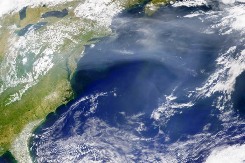By J. C. Suresh | IDN-InDepth NewsAnalysis
TORONTO (IDN) – Two eminent NASA scientists have taken up the cudgels for nuclear power, which is being increasingly pooh-poohed around the world since the Fukushima Daiichi nuclear disaster in March 2011.
A landmark study by scientist-turned-climate activist James Hansen, who has been more outspoken than virtually all of his peers on the need for climate action, and his NASA colleague Pushker Kharecha avers that nuclear power is far safer than natural gas. According to them, 1.84 million lives have been saved by the worldwide use of nuclear power instead of fossil fuels between1971 and 2009.
In their paper in the journal Environmental Science and Technology, Hansen and Kharecha write:
“On the basis of global projection data that take into account the effects of the Fukushima accident, we find that nuclear power could additionally prevent an average of 420 000–7.04 million deaths and 80–240 [gigatons of carbon dioxide equivalent] emissions due to fossil fuels by mid-century, depending on which fuel it replaces. By contrast, we assess that large-scale expansion of unconstrained natural gas use would not mitigate the climate problem and would cause far more deaths than expansion of nuclear power.”
After a close look at the paper, science writer John Upton says: “Historically, the scientists conclude that air pollution would’ve killed nearly 2 million more people between 1979 and 2001 had all of the world’s nuclear power been replaced by the burning of coal and natural gas. The findings illustrate the difference 64 gigatons less carbon dioxide (or equivalent greenhouse gases) in the atmosphere can make.”
Writing in the Scientific American, Ashutosh Jogalekar says:
“What is even more starkly clear is that the number of deaths caused by nuclear power is far lower than those saved by it; in fact there’s scant comparison. As the report notes, even the worst nuclear accident in history (Chernobyl) caused about 40 deaths; these include 28 immediate responders and about 15 deaths caused among 6000 victims of excess cancers (it’s always very difficult to detect statistically significant excess cancers in the presence of a high natural background rate).
“There have been no deaths attributable to the Three Mile Island accident. And while the verdict on Fukushima is still not definitive, the latest report on the accident predicts no direct deaths and a much lower exposure to radiation for the surrounding population than that purported to lead to fatal cancers. The bottom line is that, even assuming pessimistic scenarios, the number of deaths caused by nuclear power is a minuscule fraction of those lives which were saved by nuclear power replacing fossil fuels.”
Jogalekar comments: The authors look at deaths caused by various power sources during the period 1971-2009. To provide a comparison they build a model in which all the power which was provided by nuclear energy was hypothetically replaced by fossil fuel sources. They employ the same technique for the projected 2010-2050 period, assuming that all current nuclear power sources have been replaced by fossil fuels. Two scenarios are considered – one in which nuclear is replaced by coal and another in which it is replaced by gas. This takes into account the uncertainty regarding the nature of fossil fuel usage that’s inherent in future energy projections.
However, adds Jogalekar, the authors of the report consider only deaths and exclude from the model serious health crises such as heart failure, bronchitis and other respiratory problems; including these problems would further weaken the case for fossil fuels. The study also excludes aspects of nuclear power that cannot be easily quantified, such as deaths from nuclear proliferation.
As Jogalekar points out, nuclear-free projections for the next four decades look even more dire. Hansen and Kharecha, for example, estimate between 4 and 7 million deaths for the “All-Coal” scenario and between 420, 000 – 680, 000 deaths for an “All-Gas” energy policy. “This is something which countries like Germany and Japan that are planning to phase out nuclear must seriously consider. Only if all the nuclear power were replaced by equipotent renewable energy sources in the next four decades would these deaths be prevented. This kind of high-capacity deployment of renewables seems quite uncertain for now,” says Jogalekar.
He adds: Of course it’s not just the deaths. All the fossil fuel sources replacing nuclear power would contribute a very significant concentration of greenhouse gases to the atmosphere and severely aggravate the effects of climate change.
Hansen and Kharecha estimate an additional 80 to 240 GtCO2-equivalents of greenhouse gases from fossil fuel sources in the next forty years if nuclear power were to decline. To put this into perspective, writes Jogalekar, consider that the total amount of “allowable” input of greenhouse gases required to achieve a 350 ppm CO2 target by the end of the century is 500 GtCO2-equivalent. Nuclear power could thus reduce this load by 16-48%. Deploying some of the new promising reactor technologies could reduce this load even more. [IDN-InDepthNews – April 7, 2013]
Image: Fossil fuel pollution from North America is seen drifting across the Atlantic Ocean | Credit: NASA
2013 IDN-InDepthNews | Analysis That Matters
Send your comment | Subscribe to IDN newsletter
Follow us on Twitter and Facebook:
http://twitter.com/InDepthNews
http://www.facebook.com/IDN.GoingDeeper

